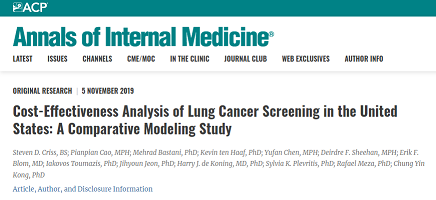Lung cancer screening with low-dose computed tomography is cost-effective, regardless of the age at which individuals stop being screened. Primary care physicians should encourage ever-smokers meeting the criteria for annual screening to adhere to this practice. Findings from a comparative modeling study are published in Annals of Internal Medicine.
Lung cancer is the leading cause of cancer death in the United States, yet only a small percent of eligible persons choose to undergo annual screening. Current guidelines include different age cutoffs beyond which screening is not recommended: 80 years for the U.S. Preventive Services Task Force (USPSTF); 77 years for the Centers for Medicare and Medicaid Services (CMS); and 74 years for the National Lung Screening Trial (NLST). Screening in an older population would detect more lung cancer cases but is associated with a higher chance of overdiagnosis and unnecessary intervention, as older participants are more likely to die of causes other than lung cancer. An important policy question is whether lowering the age cutoff would improve the cost-effectiveness of lung cancer screening.
A study by the National Cancer Institute’s (NCI) Cancer Intervention and Surveillance Modeling Network (CISNET) Lung Group, led by researchers led by researchers at MGH-ITA (Steven Criss and Joey Kong), used shared inputs for smoking behavior, costs, and quality of life to develop four microsimulation models evaluating the health and cost outcomes of annual lung cancer screening with low-dose computed tomography among current, former, and never-smokers from the 1960 U.S. birth cohort. The four models estimated that the CMS and NLST screening strategies have higher probabilities of being cost-effective than does the USPSTF strategy. Increasing the screening age cutoff resulted in greater mortality reduction but also higher costs and overdiagnosis rates, as was expected.
According to an accompanying editorial from Tufts Medical Center, these findings may help to inform health policy decisions regarding age cutoffs for lung cancer screening. The editorial suggests prioritizing policy efforts to improve screening adherence.
For more information, https://www.ncbi.nlm.nih.gov/pubmed/31683314
